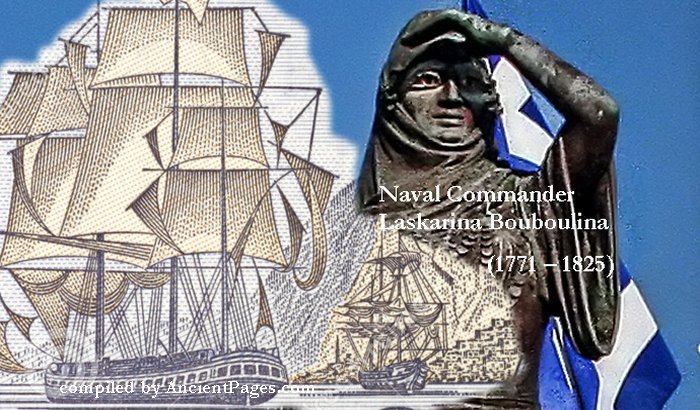Bouboulina: Heroine, Wealthy Widow And Shipowner Who Commanded A Greek Fleet Against The Ottoman Empire
A. Sutherland - AncientPages.com - A wealthy and brave shipowner, Laskarina "Bouboulina" Pinotsis (1771–1825) was a fleet commander who participated in the War of Greek Independence against the Ottoman Empire.
Bouboulina (sometimes spelled Boubalina Lascarina) was the daughter of a Greek ship's captain Stavrianos Pinotsis, from the island of Hydra, and his wife, Skevo.
She was born in prison in Constantinople (modern Istanbul) when her mother visited a dying husband there, held for participating in a failed rebellion 1769-1770 in the Peloponnese.
Stavrianos died soon after, and her mother, Skevo, took her child home to Hydra. Four years later, they moved to the island of Spetses, and Bouboulina's mother married a sea captain. The young girl grew up with hatred against the Ottomans and an interest in ships and the sea. Her stepfather also encouraged her to learn as much as possible about boats and the family business.
During her lifetime, she had two husbands, who were sea captains, and both died during encounters with the Algerian pirates who often attacked the coasts of Greece.
Bouboulina Joined The Movement Friendly Society
Left with a large inheritance and nine children, Laskarina could live a comfortable life, but she wanted to do much more. She took over management of both of her husbands' shipping businesses, and after she managed to save her money from confiscation, ordered the construction of a fleet of warships.
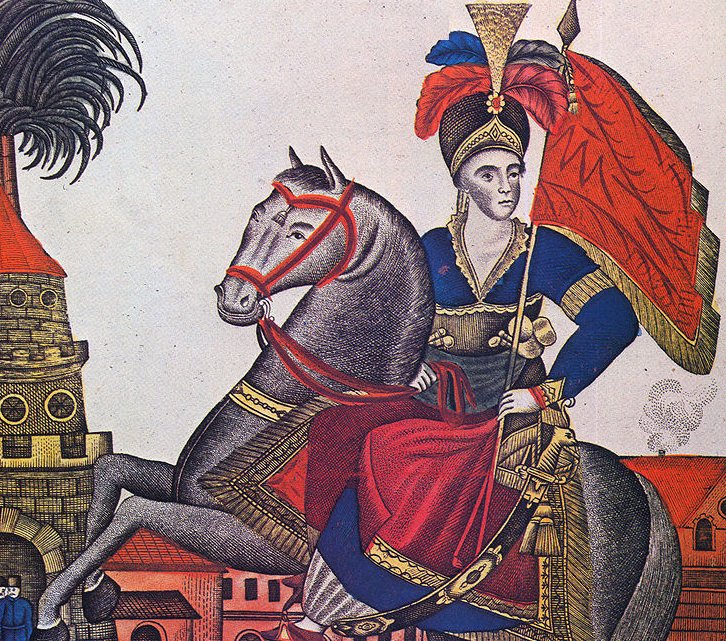 Russian engraving of Laskarina Bouboulina, the heroine of the Greek War of Independence. Source
Russian engraving of Laskarina Bouboulina, the heroine of the Greek War of Independence. Source
In Constantinople in 1818, Bouboulina joined the movement Friendly Society (Filiki Etairia), a secret society dedicated to liberating Greece from Ottoman rule founded by foreign merchants. Hundreds of affluent and educated Greek intellectuals, shipowners, clergy members, landowners, and merchants belonged to this influential underground organization;
Bouboulina was the only female member among them. Strangely, her name does not appear among the 1,093 names on the surviving membership lists of the Filiki Etairia society.
Whether she was an official member of the organization or an unofficial one-woman ladies' auxiliary, she devoted her fleet and her fortune to the independence movement." 1
In 1820, the construction of Agamemnon, a 33-meter-long ship armed with 18 heavy cannons, was completed despite many obstacles from the Turkish authorities. In the meantime, Bouboulina and her people accumulated significant ammunition and weapons, and the movement began to support the rebellion against the Ottoman Empire.
The date of the War of Greek Independence began on March 25, 1821. Bouboulina was ready; she was a fifty-year-old woman and commander of four ships in addition to the 'Agamemnon' and her small private army of 'brave lads' as she called them. They called her 'Kapetanisa' (Lady Captain).
Soon after the war broke out, on her flagship, the Agamemnon, the largest and the most impressive in the Greek fleet at the time, Bobboulina sailed to confront was against the Ottomans.
She blocked the port at Nafplion, a strategic Ottoman stronghold with massive fortifications and three hundred cannons. At the time, Nafplion was considered to be impregnable. Bouboulina showed everyone wrong.
Nineteenth-century Greek historian Anargyros Hatzi-Anargyrou wrote an eyewitness account of her assault on Nafplion:
'On December 4, 1821, as I remember, onboard her vessel, she gave orders for the boats to attack the fort. They immediately sail forward, but a rain of bullets and cannon fire from the coastal fortifications make her brave lads fall back for a moment. Like an angry Amazon, watching the battle over the side of her boat, she then shouts—'Are you women then and not men?' Forward! Her officers obey, regroup and attack—they fight but die in vain since the fort is impregnable by sea. For this reason, she lands with her forces and stays until the fall of the fort on November 30, 1822, leading her men in battle, spending her fortune..." 1
After Nafplion, the brave Bouboulina participated in several other military confrontations against the Ottomans. The most critical incident occurred in September 1821, after the Turkish position at Tripolis fell to besieging Greek forces. The city fell after three days of massacre and looting, which resulted in thirty thousand dead.
Sudden Death Of Brave Commander Bouboulina
She did not die like a brave soldier in one of the ordinary battles for Greek freedom. At the end of 1824, during the war with the Ottomans, a civil war broke out between conflicting factions of rebels over the leadership of the new Greek state.
Not only were the Ottomans Bouboulina's enemy, but she also had one private enemy, and her fiery temper led to her death.
In 1825 as the result of a family feud on the island of Spetses, someone shot at Bouboulina. She was hit in the forehead and died instantly. The killer of this tragic incident was never identified.
She was impoverished at her death; her fortune was already lost in her pursuit of Greek Independence; she lost her sons and her fleet.
She died on May 22, 1825, five years before forming an independent Greek state recognized by the European powers. Greece gave Bouboulina the honorary title of admiral after her death, and the Greek people remember her.
Written by - A. Sutherland - AncientPages.com Senior Staff Writer
Updated on December 5, 2022
Copyright © AncientPages.com All rights reserved. This material may not be published, broadcast, rewritten or redistributed in whole or part without the express written permission of AncientPages.com
Expand for referencesReferences:
1. Toler, Pamela D. Women Warriors
Jones David E. Women Warriors
Platon Alexiades, Target Corinth Canal: 1940-1944
More From Ancient Pages
-
 Why Is The Battle Of Gaugamela Called Broken ‘Camel’s Back’?
Ancient History Facts | Jul 1, 2020
Why Is The Battle Of Gaugamela Called Broken ‘Camel’s Back’?
Ancient History Facts | Jul 1, 2020 -
 Ancient Hongshan Culture: Creators Of A Pyramid And Remarkable Artifacts That Are Still Shrouded In Mystery
Civilizations | Jun 20, 2015
Ancient Hongshan Culture: Creators Of A Pyramid And Remarkable Artifacts That Are Still Shrouded In Mystery
Civilizations | Jun 20, 2015 -
 Huge Lost Ancient Underground City Of Samen Finally Reveals Its Secrets
Archaeology | Apr 28, 2017
Huge Lost Ancient Underground City Of Samen Finally Reveals Its Secrets
Archaeology | Apr 28, 2017 -
 Ullikummi – Genderless, Blind, Deaf Rock Monster Created For Strategic Purposes In Beliefs Of Hurrian People
Featured Stories | Sep 3, 2024
Ullikummi – Genderless, Blind, Deaf Rock Monster Created For Strategic Purposes In Beliefs Of Hurrian People
Featured Stories | Sep 3, 2024 -
 On This Day In History: Ensisheim Meteorite Fell To Earth – On Nov 7, 1492
News | Nov 7, 2016
On This Day In History: Ensisheim Meteorite Fell To Earth – On Nov 7, 1492
News | Nov 7, 2016 -
 Pancho Villa – Mexico’s Robin Hood – A Ruthless Bandit Or A Hero?
Featured Stories | Jul 1, 2023
Pancho Villa – Mexico’s Robin Hood – A Ruthless Bandit Or A Hero?
Featured Stories | Jul 1, 2023 -
 Oldest Known Evidence Of Artificial Cranial Deformation Revealed In Croatia
Archaeology | Aug 26, 2019
Oldest Known Evidence Of Artificial Cranial Deformation Revealed In Croatia
Archaeology | Aug 26, 2019 -
 Ancient Egypt Life and Death in the Valley of the Kings Death
Civilizations | Sep 2, 2015
Ancient Egypt Life and Death in the Valley of the Kings Death
Civilizations | Sep 2, 2015 -
 On This Day In History: The Lumière Brothers Presented Their First Film In Paris – On Dec 28, 1895
News | Dec 28, 2016
On This Day In History: The Lumière Brothers Presented Their First Film In Paris – On Dec 28, 1895
News | Dec 28, 2016 -
 First Fossils Of Ancient Human Relatives Sent To Space – Tribute To Science And Our Ancient History
Fossils | Sep 12, 2023
First Fossils Of Ancient Human Relatives Sent To Space – Tribute To Science And Our Ancient History
Fossils | Sep 12, 2023 -
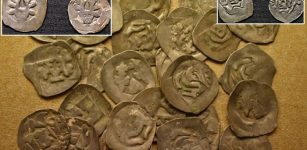 A Hoard Of Silver Coins Found Accidentally Under An Uprooted Tree Near Pieštany, Slovakia
Artifacts | Oct 28, 2020
A Hoard Of Silver Coins Found Accidentally Under An Uprooted Tree Near Pieštany, Slovakia
Artifacts | Oct 28, 2020 -
 How Extensively Did Early Farmers Utilize Europe’s Rich Forests For Raising Their Livestock?
Archaeology | Nov 13, 2024
How Extensively Did Early Farmers Utilize Europe’s Rich Forests For Raising Their Livestock?
Archaeology | Nov 13, 2024 -
 Cryptic North American Blythe Intaglios Reveal The Creator Of Life: Who Was This Unknown Being?
Featured Stories | Aug 23, 2014
Cryptic North American Blythe Intaglios Reveal The Creator Of Life: Who Was This Unknown Being?
Featured Stories | Aug 23, 2014 -
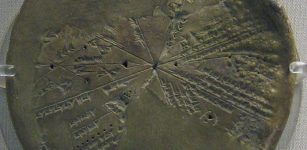 Assyrian King Ashurbanipal’s Great Library With Thousands Of Cuneiform Tablets
Civilizations | Dec 9, 2015
Assyrian King Ashurbanipal’s Great Library With Thousands Of Cuneiform Tablets
Civilizations | Dec 9, 2015 -
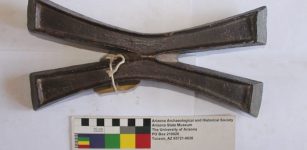 Copper Artifacts Reveal New Cultural Connections In Southern Africa
Archaeology | Mar 23, 2023
Copper Artifacts Reveal New Cultural Connections In Southern Africa
Archaeology | Mar 23, 2023 -
 Enigmatic Denisovans Interbred With Modern Humans More Than Once
Archaeology | Mar 22, 2018
Enigmatic Denisovans Interbred With Modern Humans More Than Once
Archaeology | Mar 22, 2018 -
 Krakatoa Prophecy – Samson’s Mysterious Dream
Featured Stories | Aug 6, 2019
Krakatoa Prophecy – Samson’s Mysterious Dream
Featured Stories | Aug 6, 2019 -
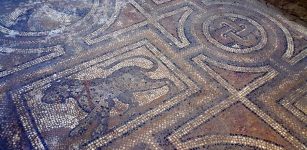 Ruins Of A Roman-Era Bath And A Floor Mosaic Discovered In Central Anatolia
Archaeology | Dec 28, 2015
Ruins Of A Roman-Era Bath And A Floor Mosaic Discovered In Central Anatolia
Archaeology | Dec 28, 2015 -
 Massive Bronze-Age Settlement Discovered Underwater in Greece
News | Sep 1, 2015
Massive Bronze-Age Settlement Discovered Underwater in Greece
News | Sep 1, 2015 -
 Were Neanderthals Really As Well Adapted To A Life In The Cold As Previously Assumed? New Study
Archaeology | Apr 26, 2022
Were Neanderthals Really As Well Adapted To A Life In The Cold As Previously Assumed? New Study
Archaeology | Apr 26, 2022

